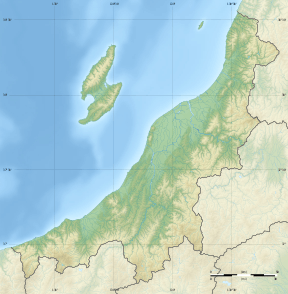Ayamezuka Kofun
Ayamezuka Kofun (菖蒲塚古墳, Ayamezuka Kofun) is an archaeological site with a keyhole-shaped kofun burial chamber located in what is now part of Nishikan-ku, Niigata in the Hokuriku region of Japan. The site was designated a National Historic Site of Japan in 1938.[1]
菖蒲塚古墳 | |
 Ayamezuka Kofun  Ayamezuka Kofun (Japan) | |
| Location | Nishikan-ku, Niigata, Japan |
|---|---|
| Region | Hokuriku region |
| Coordinates | 37°46′00″N 138°51′57″E |
| Type | Kofun |
| History | |
| Founded | Kofun period |
| Site notes | |
| Ownership | National Historic Site |
| Public access | Yes |
Overview
The site is located on the tip of a plateau on the east foot of Mount Kakuda,a 482 meter hill in far western Niigata city, within the grounds of a Buddhist temple called Kanzen-ji. It has a total length of 53 meters, a rear circle diameter of 33 meters, a height of 3 meters, and rectangular portion height of 2 meters. The internal structure of the kofun is not clear, and it appears that it did not have a stone-lined burial chamber. It was excavated in 1812 during the Edo period, at which time a bronze mirror with a pattern of dragons was discovered. This mirror is 22.7 cm in diameter and is a Niigata Prefectural Important Cultural Asset. During the Edo period, local folklore attributed the tomb to the wife of Minamoto no Yorimasa, Ayame-gozen, hence the kofun's name. It was excavated again in 2002-2003, confirming that it was indeed made in the early Kojun period. Jade magatama and cylindrical beads, pottery shards and other artifacts uncovered are stored at the Niigata City History Museum and are collectively designated an Important Cultural Property of Japan.
References
- "菖蒲塚古墳穴" [Ayamezuka Kofun] (in Japanese). Agency for Cultural Affairs.
External links
- Niigata city tourist information home page (in Japanese)